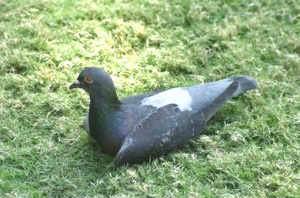Pigeon - Homing
Homing Pigeon, Rock Dove, Feral Pigeon Scientific Name: Columba livia
Sat, 5th July, 2025 - 9:54 pm GMT
Sponsor Ads:

Alternative Name
Homing Pigeon, Rock Dove, Feral Pigeon Scientific Name: Columba liviaBasic Info
Homing Pigeons are a slate blue color. The necks and wings of these birds often have iridescent shades of yellow, purple, and green. Usually, male Homing Pigeons have more of this iridescent coloration than females. Most Homing Pigeons have a dark gray blue line across their tails, and two dark bars over their wings. They also have grayish pink bills. However, there are a number of colorations available. Often, these pertain to the wing bars or tail bars. A few such phenotypes are Blue Checker, Blue Bar, Dark Checker, Red, and Spread.
Health
Homing Pigeons should be allowed lofts that have both indoor and outdoor areas. Their roosts should be located a good distance off the ground. Homing Pigeons should also be allowed drinking water at all times, and they will often bathe daily when a bath bucket is provided. Bath buckets can be particularly important in hot weather. Usually Homing Pigeons should be fed twice a day, once in the morning and once in the afternoon. Most people feed their Homing Pigeons purchased pigeon feed. Breeding Homing Pigeons normally mate for life, and pairing off can occur at almost any point during the year. Both parents will work equally to raise the chicks after nesting. The male, however, usually does the most work building the nest. In captivity, nesting materials like straw, hay, or pine needles should be provided for breeding pairs. After both parents have incubated the eggs for about 19 days, they will hatch. Normally incubation begins after the second egg in a clutch of two is laid. When the young Homing Pigeons are five days old, it is customary to band them. Normally, Homing Pigeons fledge in six weeks and are expert fliers by the time they are two months old.Habitat
N/ABehavior
Homing Pigeons are so reliable that they have been used to carry messages in times of cut-off communication between cities! These amazing birds still baffle scientists with their ability to locate their homes from extremely long distances. Normally, Homing Pigeons feed twice each day in open areas. The first feeding is usually in mid morning and the second occurs later, in the afternoon. Although Homing Pigeons normally flock, they do become territorial when nesting and will attempt to peck the heads of any intruders. These birds are found in almost all types of habitat, save in hot and cold extremes. They nest in crevices or buildings, usually in rock cliffs, barns, or urban buildings. Homing Pigeons can be recognized by their walk, during which they bob their heads back and forth. In captivity, Homing Pigeons can be trained to return home. Normally, they are given a trap door that opens into their loft that the birds can push into. Training usually begins when the young birds are two months old. They are released a short distance from the loft and thus trained to use the trapdoor. Homing Pigeons are then released at increasing distances from the loft. By the time the Homing Pigeons have proved able to return home from a 40 mile distance, they are considered to be fully trained.Origin
Asia and AfricaHistory
Although Homing Pigeons are native to North Africa, southwestern Asia, and Europe, they are found worldwide. Raptors, opossums, and raccoons prey on Homing Pigeons in the wild. These birds are often kept in captivity as pets. They have also been used in laboratory research, where their interesting flight instincts, the genetics of their color patterns, and their evolutionary tracks have been studied. Despite these studies, the Homing Pigeons homing instinct remains largely unexplained. Many scientists believe that it has something to do with the earth's magnetism, or perhaps the recognition of definitive markings on the landscape, from the air. Historically, Homing Pigeons have been used to carry messages between cities and have made flights that lasted more than 2,300 miles (3,700 kilometers). Today, hobbyists often use Homing Pigeons in racing trials, where the birds are released and the time it takes them to return to their lofts is clocked.Common Foods
Homing Pigeons normally eat seeds, grains, leaves, and other materials in the wild. Wild birds living in urban areas also eat food scraps like popcorn, bread, or peanuts.Sponsor Ads:
Never do card tricks for the group you play poker with. -- Unknown
Pigeon - Homing
Coded by: BGID® | ALL RIGHTS RESERVED Copyright © 2000-2025
Disclaimer | Privacy | Report Errors / Contact | Credits

 Preparing For China. China is growing their military. China Military Technology - can it keep up with the US?
Preparing For China. China is growing their military. China Military Technology - can it keep up with the US?  versus
versus 

 versus
versus 
 This Thread is about the North Korean Military itself - the kind of army, navy, and air force they have.
This Thread is about the North Korean Military itself - the kind of army, navy, and air force they have. 
 versus
versus 
 versus
versus  versus
versus